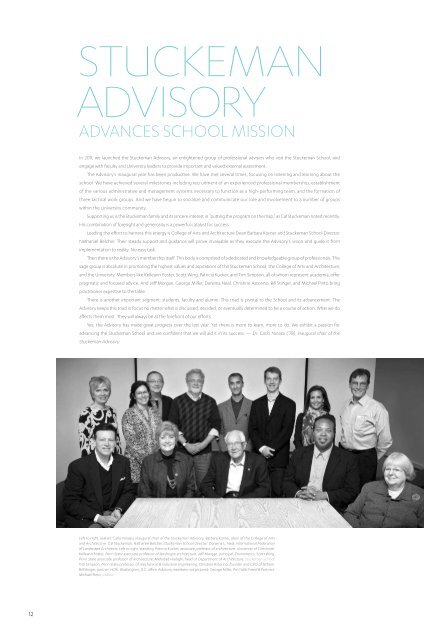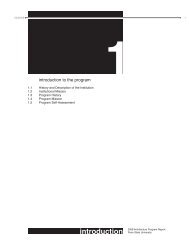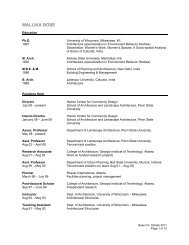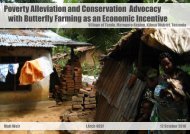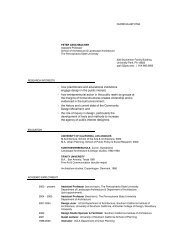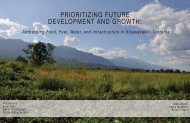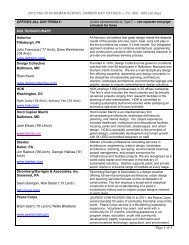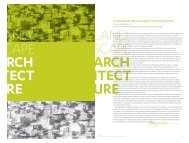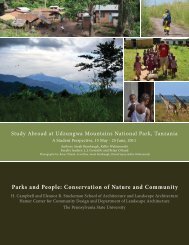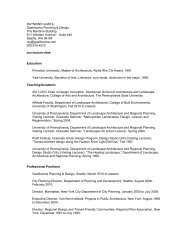THE STUCKEMAN ANNUAL - Stuckeman School
THE STUCKEMAN ANNUAL - Stuckeman School
THE STUCKEMAN ANNUAL - Stuckeman School
Create successful ePaper yourself
Turn your PDF publications into a flip-book with our unique Google optimized e-Paper software.
<strong>STUCKEMAN</strong><br />
ADVISORY<br />
ADVANCES SCHOOL MISSION<br />
HAMER CENTER CELEBRATES TEN<br />
YEARS OF “BUILDING COMMUNITY<br />
THROUGH BUILDING KNOWLEDGE”<br />
<strong>Stuckeman</strong> <strong>School</strong><br />
Develops New<br />
Geodesign Graduate<br />
Programs<br />
In 2011, we launched the <strong>Stuckeman</strong> Advisory, an enlightened group of professional advisers who visit the <strong>Stuckeman</strong> <strong>School</strong>, and<br />
engage with faculty and University leaders to provide important and valued external assessment.<br />
The Advisory’s inaugural year has been productive. We have met several times, focusing on listening and learning about the<br />
school. We have achieved several milestones including recruitment of an experienced professional membership, establishment<br />
of the various administrative and management systems necessary to function as a high-performing team, and the formation of<br />
three tactical work groups. And we have begun to socialize and communicate our role and involvement to a number of groups<br />
within the University community.<br />
Supporting us is the <strong>Stuckeman</strong> family and its sincere interest in “putting the program on the map,” as Cal <strong>Stuckeman</strong> noted recently.<br />
His combination of foresight and generosity is a powerful catalyst for success.<br />
Leading the effort to harness this energy is College of Arts and Architecture Dean Barbara Korner and <strong>Stuckeman</strong> <strong>School</strong> Director<br />
Nathaniel Belcher. Their steady support and guidance will prove invaluable as they execute the Advisory’s vision and guide it from<br />
implementation to reality. No easy task.<br />
Then there is the Advisory’s membership itself. This body is comprised of a dedicated and knowledgeable group of professionals. This<br />
sage group is absolute in promoting the highest values and aspirations of the <strong>Stuckeman</strong> <strong>School</strong>, the College of Arts and Architecture,<br />
and the University. Members like Kelleann Foster, Scott Wing, Patricia Kucker, and Tim Simpson, all of whom represent academia, offer<br />
pragmatic and focused advice. And Jeff Morgan, George Miller, Darwina Neal, Christine Astorino, Bill Stinger, and Michael Pinto bring<br />
practitioner expertise to the table.<br />
There is another important segment: students, faculty and alumni. This triad is pivotal to the <strong>School</strong> and its advancement. The<br />
Advisory keeps this triad in focus no matter what is discussed, decided, or eventually determined to be a course of action. What we do<br />
affects them most. They will always be at the forefront of our efforts.<br />
Yes, the Advisory has made great progress over the last year. Yet there is more to learn, more to do. We exhibit a passion for<br />
advancing the <strong>Stuckeman</strong> <strong>School</strong> and are confident that we will aid it in its success. — Dr. Carlo Ninassi (’78), inaugural chair of the<br />
<strong>Stuckeman</strong> Advisory<br />
In November 2011, the Hamer Center for Community Design showcased more than ten years of<br />
work focusing on community engagement and improving community quality of life. Students<br />
Andrew McHenry (’12 B.L.A.) and Noah Goldman (’12 B.Arch.) organized the Rouse Gallery<br />
exhibition with help from faculty members Peter Aeschbacher and Mallika Bose. The kickoff,<br />
attended by Don Hamer, featured a public lecture by Associate Professor of Landscape<br />
Architecture Larry Gorenflo, who presented work completed as a 2011 Hamer Center Fellow.<br />
As the Hamer Center celebrated its past, it embarked on a variety of projects involving<br />
students and faculty that will continue to aid communities in the future.<br />
Research from Hamer Center interns Bryan Heritage (’12 B.Arch.) and Abigail Thomas (’11<br />
B.L.A.) was one of four projects selected to represent Penn State at the fall 2011 Undergraduate<br />
Research at the Capitol event in Harrisburg.<br />
The students’ poster, The River Town Assessment Tool: A Process to Revitalize River Towns<br />
in the Susquehanna Valley, showcases their work on the River Town Assessment process,<br />
a joint program of the Hamer Center; the Susquehanna Greenway Partnership; and SEDA-<br />
Council of Governments (SEDA-COG), a public development organization serving eleven<br />
central Pennsylvania counties.<br />
Thomas and Heritage worked with members of SEDA-COG and the Susquehanna<br />
Greenway Partnership to finalize the assessment process, which provides direction for<br />
communities’ long-term sustainable development as river towns. They then worked with<br />
stakeholder groups in Shickshinny and Montgomery to pilot test the tool, using it to create<br />
designs that reflected the community members’ visions. They also presented this work at the<br />
annual Environmental Design Research Association (EDRA) conference in Seattle, Washington.<br />
Katie Hess-Reichard (’12 M.L.A.) worked with the Borough of Juniata Terrace to successfully<br />
complete a Pennsylvania Historic Resources Survey Form, an application for recommendation<br />
to the National Register of Historic Places. She is now helping the community submit the final<br />
application. Once Juniata Terrace is awarded National Register status, the borough will be<br />
eligible for a variety of grants that can then be used for improvements.<br />
In the spring semester, Bose co-presented at the fifteenth annual Community Campus<br />
Partnership for Health Conference in Houston, Texas, with former assistant professor<br />
Caru Bowns and community partner Jim Wilson, executive director of the Danville Business<br />
Alliance. They detailed the impact of a series of projects led by students and faculty in Danville<br />
since fall 2008.<br />
Under the direction of Bose, the Hamer Center has continued its commitment to<br />
“building community through building knowledge.” Bose, who has decided not to seek reappointment<br />
as director, “deserves great credit for the stability of the Hamer Center, as well as<br />
the leadership and engaged consult of her advisory board,” said <strong>Stuckeman</strong> <strong>School</strong> Director<br />
Nathaniel Belcher. “I want to thank her for her service to the <strong>Stuckeman</strong> <strong>School</strong>, and wish her<br />
well as she returns to the faculty.”<br />
Visit hamercenter.psu.edu to see a complete list of Hamer Center projects, and stay<br />
tuned for news from the new leadership. —M.M.<br />
A symbiosis between science and design generates deeply<br />
informed solutions to challenges that no discipline can<br />
solve on its own. Recognizing the value of interdisciplinary<br />
collaboration that combines critical thinking and<br />
creativity, Penn State is launching graduate-level<br />
geodesign programs. While geodesign has deep roots in<br />
landscape architecture, the name and the formalization<br />
of a proven framework are more recent.<br />
The September 2011 visit of Carl Steinitz, Eleanor<br />
R. <strong>Stuckeman</strong> Chair in Design, dovetailed well with the<br />
programs’ initiation. Carl is author of A Framework for<br />
Geodesign (Esri, 2012), which outlines the process he has<br />
refined for more than thirty years. He is among several<br />
experts who have provided astute feedback on our ideas.<br />
In June 2012 we honed our programs with the first<br />
meeting of our Geodesign Advisory Board. Outside<br />
experts on the board include Sven Bilen, Penn State <strong>School</strong><br />
of Engineering Design, Technology, and Professional<br />
Programs; Stephen Ervin, Harvard University; Brian Lee,<br />
University of Kentucky; Bill Miller, Esri; Doug Miller and<br />
Anthony Robinson, Penn State, Master of Geographic<br />
Information Science program; Jim Sipes, Sand County<br />
Studios; and Steinitz, Harvard University.<br />
Collaborating with our colleagues at Penn State’s John<br />
A. Dutton e-Education Institute, a unit of the College of<br />
Earth and Mineral Sciences, we are launching our program<br />
with a geodesign option within the MGIS degree. Late in<br />
2013 we plan to offer a master’s certificate in geodesign.<br />
Once final approvals are secured, we intend to offer a<br />
master’s in professional studies (MPS) in geodesign.<br />
Those completing the certificate will be able to apply to<br />
the MPS program.<br />
These programs will be offered completely online via<br />
Penn State’s World Campus, the result of a partnership<br />
between the <strong>Stuckeman</strong> <strong>School</strong> and the College of Arts<br />
and Architecture’s e-Learning Institute. My sabbatical at<br />
GIS technology firm Esri focuses on researching optimal<br />
online studio environments. Track developments at<br />
geodesign.psu.edu. —Kelleann Foster, RLA, ASLA<br />
Left to right, seated: Carlo Ninassi, inaugural chair of the <strong>Stuckeman</strong> Advisory; Barbara Korner, dean of the College of Arts<br />
and Architecture; Cal <strong>Stuckeman</strong>; Nathaniel Belcher, <strong>Stuckeman</strong> <strong>School</strong> director; Darwina L. Neal, International Federation<br />
of Landscape Architects. Left to right, standing: Patricia Kucker, associate professor of architecture, University of Cincinnati;<br />
Kelleann Foster, Penn State associate professor of landscape architecture; Jeff Morgan, principal, Environetics; Scott Wing,<br />
Penn State associate professor of architecture; Mehrdad Hadighi, head of Department of Architecture, <strong>Stuckeman</strong> <strong>School</strong>;<br />
Tim Simpson, Penn State professor of mechanical & industrial engineering; Christine Astorino, founder and CEO of fathom;<br />
Bill Stinger, partner, HOK, Washington, D.C. office. Advisory members not pictured: George Miller, Pei Cobb Freed & Partners;<br />
Michael Pinto, Osborn<br />
ABOVE & RIGHT<br />
Hamer Center interns Bryan Heritage (’12 B.Arch.) and Abigail Thomas<br />
(’11 B.L.A.) work on the River Town Assessment process.<br />
TOP:<br />
Left to Right: Carl Steinitz, fall 2011 Eleanor R. <strong>Stuckeman</strong> Chair in Design;<br />
Ray Gastil, <strong>Stuckeman</strong> <strong>School</strong> Chair in Design Innovation; Stephen Ervin,<br />
Harvard University Graduate <strong>School</strong> of Design; and Brian Lee, University<br />
of Kentucky. Photo by Michael Palmer.<br />
BOTTOM:<br />
Carl Steinitz provided valuable commentary during the Geodesign<br />
Advisory Board meeting in June 2012. Photo by Michael Palmer.<br />
12<br />
13


